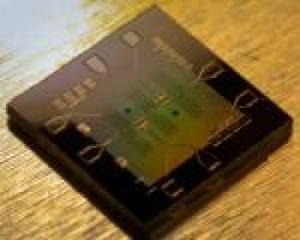Feb 16 2011
An important milestone toward the realization of a large-scale quantum computer, and further demonstration of a new level of the quantum control of light, were accomplished by a team of scientists at UC Santa Barbara and in China and Japan.
The study, published in the Feb. 7 issue of the journal Physical Review Letters, involved scientists from Zhejiang University, China, and NEC Corporation, Japan. The experimental effort was pursued in the research groups of UCSB physics professors Andrew Cleland and John Martinis.
 This is an image of a chip containing the superconducting integrated circuit used to generate NOON microwave states.
This is an image of a chip containing the superconducting integrated circuit used to generate NOON microwave states.
The team described how they used a superconducting quantum integrated circuit to generate unique quantum states of light known as "NOON" states. These states, generated from microwave frequency photons, the quantum unit of light, were created and stored in two physically-separated microwave storage cavities, explained first author Haohua Wang, postdoctoral fellow in physics at UCSB. The quantum NOON states were created using one, two, or three photons, with all the photons in one cavity, leaving the other cavity empty. This was simultaneous with the first cavity being empty, with all the photons stored in the second cavity.
"This seemingly impossible situation, allowed by quantum mechanics, led to interesting results when we looked inside the cavities," said second author Matteo Mariantoni, postdoctoral fellow in physics at UCSB. "There was a 50 percent chance of seeing all the photons in one cavity, and a 50 percent chance of not finding any –– in which case all the photons could always be found in the other cavity."
However, if one of the cavities was gently probed before looking inside, thus changing the quantum state, the effect of the probing could be seen, even if that cavity was subsequently found to be empty, he added.
"It's kind of like the states are ghostly twins or triplets," said Wang. "They are always together, but somehow you never know where they are. They also have a mysterious way of communicating, so they always seem to know what is going to happen." Indeed, these types of states display what Einstein famously termed, "spooky action at a distance," where prodding or measuring a quantum state in one location affects its behavior elsewhere.
The quantum integrated circuit, which includes superconducting quantum bits in addition to the microwave storage cavities, forms part of what eventually may become a quantum computational architecture.
Source: http://www.ucsb.edu/